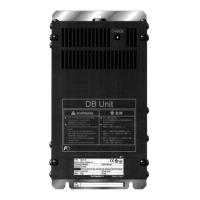4.8 Configuring Function Codes for Drive Controls
4-16
[ 4 ] Driving a non-Fuji motor or Fuji non-dedicated IM under vector control with/without
speed sensor
(1) Configuring the function codes of motor parameters
When “driving under vector control with speed sensor (F42* = 6)” or “vector control without speed sensor (dynamic
torque vector, F42* = 1)”, it is necessary to set the motor parameters.
Execute auto tuning when driving non-Fuji or Fuji non-dedicated vector motor (non-VG motor) under “vector control
(F42*=6) with speed sensor” or any motor under “vector control without speed sensor (dynamic torque vector) (F42*
= 1)”.
Configure the function codes listed below according to the motor ratings and design values of the machine. For the
motor ratings, check the ratings printed on the motor's nameplate. For design values of the machine, ask system
integrators or machine manufacturers about them.
Execute auto tuning after setting values and initializing the motor (H03=2).
For details on how to modify the function code data, see Chapter 3 “3.4.1 Setting up function codes “Data
Setting:
!f__
through
!o__
”.”
Function
code
Name Function code data
p
99
*
Motor 1 selection 4: Other motors
f
04
*
Base frequency 1
Motor rated value (printed on motor rating nameplate)
If the motor synchronous rotation speed (min
-1
) is identified, calculate
F05 by the following formula and set it.
poles of Number
120
speed rotation sSynchronou
×
f
05
*
Rated voltage
at base frequency 1
p
01
*
Motor 1 (No. of poles)
p
02
*
Motor 1 (Rated capacity)
p
03
*
Motor 1 (Rated current)
p 06
*
Motor 1 (No-load current)
In case of difficult to execute rotation tuning:
Set the value in the motor test report or the value calculated by the
following formula.
If rotation tuning is possible:
By tuning
f
03
*
Maximum frequency 1
Design specification
Note) For the test run of the motor, increase values so that they are
longer than your machine design values. If the specified time is
short, the inverter may not run the motor properly.
f
07
Acceleration time 1 (Note)
f
08
Deceleration time 1 (Note)
When accessing the function code P02*, take into account that changing the P02* data automatically
updates the data of the function codes P03*, P06* to
P13*, P16* to P20*, P53*, P55*, and H46.
If the motor is used under vector control with speed sensor, it is recommended to use the
motor whose rated voltage is designed to be lower than the power voltage.
If the general-purpose motor is used under vector control, the rated voltage (ba
becomes equal to the input voltage and there is no voltage margin to control with vector control.
might increase the motor current exceeding the rating current and might occur
After the above configuration, initialize motor 1 with the function code (H03 = 2). It automatically updates
the motor parameters P01*,
P03*, P06* to P13*, P16* to P20*, P53*, P55*, and H46.
(2) Configuring the function codes concerning a PG (pulse generator) and PG signals
For details, refer to “4.8.1 [ 3 ] (2) Configuring the function codes concerning a PG (pulse generator) and PG signals”

